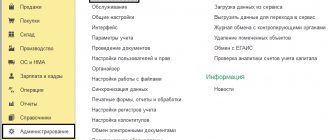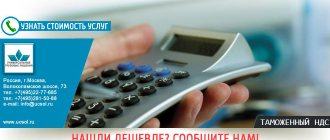Kontur.Accounting is a web service for small businesses!
Quick establishment of primary accounts, automatic tax calculation, online reporting, electronic document management, free updates and technical support.
Try it
Kazakhstan and Russia are members of the EAEU customs union, so they have a single customs territory. This makes importing easier: there is no need to go through customs clearance, declaration, or pay duties. At the same time, the import of goods from the countries of the customs union differs from imports from third countries in the procedure for paying VAT and the rules for preparing documents. Read the article on how to register the import of goods from Kazakhstan and pay taxes.
Rules for importing goods into the Russian Federation
The rules that apply when calculating VAT on goods transported to the territory of the Russian Federation are determined by the presence of customs at the state border. Tax is calculated at the time of import of goods.
The procedure for calculating and paying royalties is subject to customs legislation. The tax is paid to the customs service.
Between a number of states that were previously part of the Soviet Union, customs was abolished.
These states were united into the EAEU - the Eurasian Economic Union. Now the import and export of goods across the borders of the countries participating in this treaty follow the same rules of interaction.
These rules were set out in the agreement on the EAEU, which was concluded in Astana in 2014.
You can read the text of the agreement on our website.
When importing from Kazakhstan, as well as when importing goods into Kazakhstan from Russia, the following customs rules are now relevant in relation to VAT:
- taking into account the absence of customs, the importer undertakes to independently calculate VAT and pay it;
- the tax base is calculated taking into account the cost of exported products;
- the price indicated in foreign currency is recalculated at the exchange rate on the date the goods were accepted for accounting;
- the optimal period is the 20th day of the month, which follows the month in which the export products were imported. If the end of the period coincides with a weekend or holiday, then for the Russian Federation it is possible to shift to another date that corresponds to the nearest weekday.
More detailed rules can be found by following the link.
It is also recommended that you read Article 6.1 of the Tax Code of the Russian Federation.
Watch the video: registration of goods when importing from EAEU countries.
Read on our website: list of prohibited goods for import into Russia.
Russian customs clearance rules
In our country, customs clearance has always been a prerequisite for the legal import and use of vehicles. From January 1, 2021, the answer to the question of how to clear a car through customs in Russia is provided by the EAEU Customs Code, ratified by Federal Law No. 317-FZ dated November 14, 2017. The general procedure includes:
- placing a security deposit before going to pick up the car;
- an oral statement by the owner of his intentions with the provision of a certain package of documents after arrival at customs;
- handing over the car to a warehouse;
- obligatory payments;
- receiving a new PTS.
In addition, according to the amendments dated January 30, 2013, introduced into the technical regulations of the Customs Union TR CU 018/2011, from January 1, 2021, the import of passenger cars into the Russian Federation without a GLONASS unit is prohibited. This made the process more difficult.
Procedure for payment of VAT
When goods are imported into Russia, VAT is paid by the importer. This applies to everyone who makes purchases in Russia.
The difference is that when transporting products from countries that do not belong to the member countries of the customs union, the tax is paid when passing customs control.
When importing from the EAEU, money is transferred by the entrepreneur to the budget through the Federal Tax Service.
This applies to goods that were produced on the territory of states that are members of the EAEU and are put into free circulation on the territory of the Eurasian Economic Union.
Meat and poultry
Perhaps the most famous meat processing plant. It makes more than 80 types of sausages and offers national horse meat products and fresh meat. also included in the Forbes list. Stewed meat and canned goods “Kubley” are often among the most popular Kazakh goods. Member of the Almaty Public Council Marat Shibutov recommends that Russian businessmen also pay attention to Rubikom meat products, Damdy et turkey, Alatau kus chicken, and Alimpiev sausages. Export sales of meat and poultry amounted to $10.518 million (7,479 tons).
How is tax calculated?
The price of products that are imported into Russia can be determined under a sales contract. The transaction price reflected in the contract and the one paid to the seller by the buyer are taken into account. The tax base for VAT does not increase due to the presence of expenses for the transportation of goods.
The final tax amount that is paid to the budget can be calculated using the following formula:
price of imported products + excise taxes (relevant for excisable products) x tax rate (10–18%).
Probability of error
The tax amount is billed by the seller according to the documentation, in accordance with current legislation.
Against this background, the person purchasing the goods determines the VAT independently and then makes payments to the Federal Tax Service.
The tax base is necessarily calculated on the date when the goods were accepted for accounting.
It is necessary to proceed from the final price of the product. If it was purchased for foreign currency, then the amount in rubles can be determined by converting it into foreign currency at the Central Bank exchange rate. In this case, the date when the imported products were accepted for accounting is taken into account.
This base is multiplied by the tax rate. Then the amount to be deposited is determined.
Accounting for imported goods from the Republic of Kazakhstan
The order is presented in the table:
| Operation | Debit | Credit |
| Price of goods imported from the Republic of Kazakhstan | 42 | 61 |
| Paid imported products | 61 | 52 |
| Tax accrued for payment | 20 | 69 |
| Return of sales proceeds | 63 | 90-2 |
Example.
In July, Slon LLC imported products from Kazakhstan to Russia for further resale. The cost under the supply agreement is 500.0 thousand rubles.
The amount of VAT that was paid by the company to the budget of the Russian Federation amounted to 90.0 thousand rubles. (at a tax rate of 18%).
Foreign trade contract with Kazakhstan
Although Russia and Kazakhstan have a single customs territory, the legislation of the countries is not uniform. When concluding a supply agreement, the parties must determine the law applicable to the concluded agreement; they can be guided by Incoterms.
Foreign economic activity begins with the preparation of a foreign trade contract. It takes into account the legislation of both parties to the transaction and includes:
- names of companies of the parties to the contract;
- purpose of the agreement;
- terms of payment: payment currency, contract amount, payment terms, fines, liability for delay;
- delivery conditions;
- procedure for action in case of force majeure;
- details of organizations;
- settlement of disputes.
If any conditions were missed, they can be included in an additional agreement to the contract.
According to the rules, all clauses of the contract must be interpreted unambiguously and the contract must be drawn up in two languages - Kazakh and Russian. Each contract has a number, place and date of signing, these are indicated in the specifications.
Payment under the contract can be made in rubles or tenge; in any case, you will need a foreign currency account for settlements. Submit to the bank a payment order, a certificate of currency transactions and other documents that the bank requests.
There are no more transaction passports, but contracts must be registered with the bank. Moreover, only those that exceed the limit - 3 million rubles for imports to Russia and 6 million rubles for exports.
VAT reporting
The company submits a declaration.
The following documents are attached to it:
- application (4 copies, paper and electronic versions);
- Bank statement;
- shipping documentation;
- invoice;
- agreement for the purchase of products;
- intermediary agreement (upon its conclusion).
All documentation is provided in the form of photocopies, which are notarized. The exception is the application - it is submitted in the original.
The same requirements are relevant when exporting to Kazakhstan.
A desk audit is required. If during the process no discrepancies are identified, then the inspection undertakes to put a VAT payment stamp on all copies of the application. Duration – 10 days.
The tax office returns three copies of the application with a mark to the applicant. The applicant gives two copies to the exporter, one remains with him.
Changes in EAEU legislation
TCEAES came into force on 01/01/2018. The new document calls for ensuring unified customs regulation on the territory of the EAEU, creating acceptable conditions for participants in foreign economic activity, as well as simplifying customs formalities.
Main changes:
- providing participants with the opportunity to take advantage of a deferred payment of import customs duties (period - no more than 30 days);
- presentation of a product declaration without documentation that confirms the declared information;
- improvement of the institution of authorized economic operator;
- providing the opportunity to make additions to the product declaration.
More details about the changes can be found at the link.
How long does it take for a car from Kazakhstan to stay in Russia?
In 2021, you can drive a non-customs-cleared car in Russia for no more than six months if you obtain a temporary operating permit. After this period, it is necessary to renew the vehicle permit (at the local customs office) or leave the country. In the second case, temporary import is closed at the customs point.
An application for termination of temporary importation (or its extension) must be submitted within 15 working days to the customs point where the initial clearance was carried out. If this is not done, the vehicle will be entered into the “not exported” database. As a result, all established customs duties will be collected.
Returning to the Russian Federation using an exported vehicle is possible subject to compliance with the established deadlines. In this case, you will need to go through the import clearance procedure again and pay mandatory taxes and duties (if the applicant is a Russian citizen). To undergo this procedure in 2021, you will need to provide the following list of documents:
- Passport of a citizen of the Russian Federation.
- OSAGO policy.
- PTS.
- Completed declaration.
Some drivers, in order to save money, decide to purchase a used car in Europe without registering ownership, thinking that they will be able to operate it in Russia for 2 months under a general power of attorney. To their disappointment, only foreign citizens who come to our country in private cars have this right. This option does not apply to Russians.
Our journalists are not afraid to get the truth and show it to you. In a country where the authorities constantly want to ban something, including banning telling the truth, there must be publications that continue to engage in real journalism.
We want to depend only on you - those who want to know the truth, those who are not afraid to be free. Help us tell you the truth.
Please support us with your contribution to independent journalism!
January 2020
| Mon | W | Wed | Thu | Fri | Sat | Sun |
| 1 | 2 | 3 | 4 | 5 | ||
| 6 | 7 | 8 | 9 | 10 | 11 | 12 |
| 13 | 14 | 15 | 16 | 17 | 18 | 19 |
| 20 | 21 | 22 | 23 | 24 | 25 | 26 |
| 27 | 28 | 29 | 30 | 31 | ||
Changes in legislation regarding customs clearance of cars
- On April 1, 2021, recycling collection rates were increased. The new coefficients are shown in the table.
- From January 1, 2021, new excise tax rates will apply. The new rates are shown in the table.
- From September 1, 2021, zero duties on the import of electric vehicles have been abolished.
Customs clearance of cars in Russia So, what duties and taxes need to be paid when clearing a car through customs. We are talking about cars with gasoline, diesel and hybrid engines. There are separate rules for customs clearance of electric vehicles, which are described below.
- Customs clearance fee. The fee amounts are shown below.
- Customs duty.
- Recycling collection. Both individuals and legal entities pay. The calculation is described below.
- VAT. Only legal entities pay.
Documents for customs clearance
List of documents for customs clearance:
- passports of the director and chief accountant;
- constituent documentation, as well as documents on the organization;
- balance sheet of the foreign trade entity for the last reporting period;
- company charter;
- order on the appointment of a chief accountant;
- memorandum of association + amendments;
- decision of the meeting on the appointment of a director;
- tax registration certificate;
- certificates from banks.
For a list of additional documents, see the link.
We recommend watching the video: the procedure for registering customs duties on goods imported from the EAEU countries.
Is it worth driving a non-customs cleared car?
As already noted, you don’t have to think about customs clearance for a year if the car has been temporarily imported. The period can be extended under certain circumstances. In other cases, you are given a day to declare your desire to go through the customs clearance procedure. If you simply drive a car using some kind of semi-criminal scheme, you can lose it.
More on AutoLex.Net:
Customs clearance of cars from America (USA) in 2021: how much does it cost, how to clear customs?










